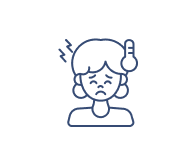What is typhoid?
The first step to prevention is understanding it.
Typhoid is a severe infection caused by Salmonella typhi.[1] It is a type of enteric fever that spreads through contaminated food and water.[2] The bacteria exclusively live in humans, and our bodies can carry them for extended periods (sometimes for years) without showing any symptoms, unknowingly transmitting them to others. If contaminated food or water is ingested, the bacteria invade the intestinal tract and then spread via the bloodstream to other parts of the body.[3] Without appropriate treatment, typhoid can lead to severe complications and pose life-threatening risks. Children tend to be disproportionately affected by this disease, mostly affecting those aged 5 to 15.[4]
Difference between typhoid and paratyphoid
Typhoid’s definition is similar to paratyphoid. Both are similar diseases caused by two variations of the Salmonella enterica bacteria. Both diseases have similar symptoms, but paratyphoid is less severe and less common than typhoid.4

How does it spread?
Shedding
Typhoid spreads through a process called ‘shedding’, where the bacteria exit the body of the infected person while defecating. You may get typhoid if you consume food or drinks handled by a person shedding the Salmonella typhi bacteria.[5]
Ingestion
People get sick after ingesting the bacteria. This usually happens through food or drinks that are contaminated by sewage, by eating on plates rinsed in contaminated water, or eating food touched by someone who did not wash their hands after using the washroom.[6]

Contaminated food & water
It can also spread through food items that are not washed or cooked properly, like fruits and salads, or through contaminated drinking water in the form of unsafe ice cubes or unsafe fruit juices.[7]

Chronic Carriers
People infected by typhoid carry the bacteria in their intestinal tract, which is shed from time to time in their excreta. In some cases, people who have recovered from typhoid can harbour the bacteria in their intestines for a long time. They may no longer have the symptoms but continue to spread the bacteria.[1]
What are the risk factors?
Research shows that India likely has over half of the world’s typhoid cases, based on studies that combine community and hospital data while accounting for unreported cases.[8,9]

In the initial stages, patients usually experience a fever along with headache, nausea and abdominal pains. However, if untreated, it can lead to severe complications.[1]

Typhoid can lead to ulcers in small intestines, which can also lead to bleeding from the intestines. In some severe cases, it enters the bloodstream from damaged walls of the small intestine, leading to sepsis. In other cases, it can cause inflammation in the lining of the heart, pancreas or brain and can also affect the kidneys.[7]

Some patients with typhoid fever can develop neurological issues like encephalopathy, confusion, sleep problems, psychosis, delirium and muscle stiffness.[10]

It may also cause hepato-splenomegaly, a condition where both the liver and spleen are enlarged.[9] A chronic carrier state may increase the risk of gallbladder cancer.[11]
Resources
- https://www.who.int/news-room/fact-sheets/detail/typhoid
- https://iapindia.org/pdf/Ch-008-Enteric-Fever.pdf
- https://pmc.ncbi.nlm.nih.gov/articles/PMC9304857/
- https://www.nicd.ac.za/wp-content/uploads/2022/06/Enteric-Fever_NICD-recommendations_June-2022_final.pdf
- https://acvip.org/parents/columns/typhoid.php
- https://www.cdc.gov/typhoid-fever/about/index.html
- https://www.mayoclinic.org/diseases-conditions/typhoid-fever/symptoms-causes/syc-20378661
- https://www.nejm.org/doi/pdf/10.1056/NEJMoa2209449
- https://pubmed.ncbi.nlm.nih.gov/35238365/
- https://www.ncbi.nlm.nih.gov/books/NBK557513/
- https://pmc.ncbi.nlm.nih.gov/articles/PMC8190372/
Disclaimer: A public awareness initiative by Bharat Biotech International Limited. This information is for general awareness only and does not constitute medical advice. The doctors, medical facilities and graphics shown are for illustrative purposes only. For any medical advice or any question or concern you may have regarding your condition, consult your doctor.